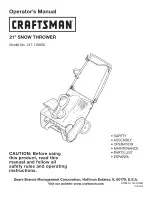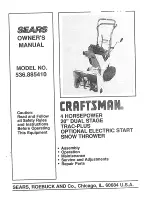
18
1
Figure 15
1.
Hydraulic filter
3. Lubricate new filter gasket and fill the filter with
hydraulic oil.
4. Assure filter mounting area is clean. Screw filter on
until gasket contacts mounting plate. Then tighten filter
one–half turn.
5. Start tractor engine and operate hydraulic controls to
purge air from the system. Stop the engine and check oil
level. Also check for any leaks.
Checking Hydraulic Lines And
Hoses
Check hydraulic lines and hoses daily for leaks, kinked
lines, loose mounting supports, wear, loose fittings, weather
deterioration and chemical deterioration. Make all
necessary repairs before operating.
Hydraulic fluid escaping under pressure can
penetrate skin and cause injury.
•
Make sure all hydraulic fluid hoses and lines are
in good condition and all hydraulic connections
and fittings are tight before applying pressure to
the hydraulic system.
•
Keep your body and hands away from pin hole
leaks or nozzles that eject high pressure
hydraulic fluid.
•
Use cardboard or paper to find hydraulic leaks.
•
Safely relieve all pressure in the hydraulic
system before performing any work on the
hydraulic system.
•
Seek immediate medical attention if fluid is
injected into skin.
Warning
Adjusting the Impeller Belt
Make sure belt is properly tensioned to ensure proper
operation of the machine and unnecessary wear. Check belt
frequently.
Note: Check/adjust the impeller belt tension after the first
20 hours of operation.
1. Remove the capscrews, washers and nuts securing the
drive shield to the impeller housing (Fig. 16). Remove
the shield.
1
Figure 16
1.
Drive shield
Note: The drive shaft does not have to be disconnected to
adjust the belt.
2. On back side of frame, loosen capscrew securing belt
tensioner to frame.
1
2
3
4
Figure 17
1.
Tensioner guide
2.
Capscrew & nut
3.
Capscrew (back of frame)
3. Remove capscrew and nut securing tensioner guide to
drive mount (Fig. 17). Belt tension will be released
when capscrew is removed.



































